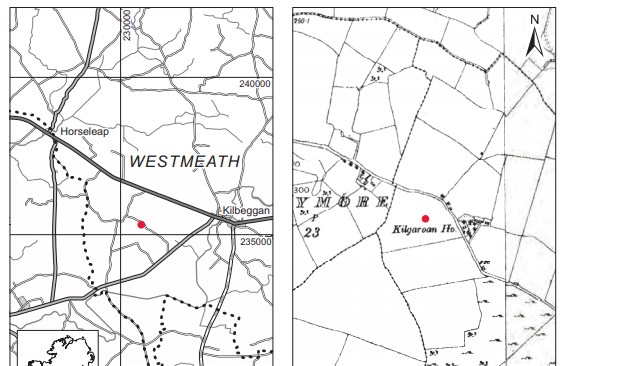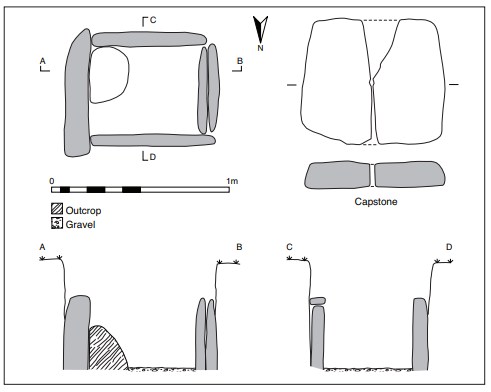County: Westmeath Site name: KILGAROAN, CO. WESTMEATH
Sites and Monuments Record No.: SMR WM037-010SMR WM037-009 Licence number: E1171
Author: ELLEN PRENDERGAST
Site type: Early Bronze Age graves
Period/Dating: —
ITM: E 629961m, N 735040m
Latitude, Longitude (decimal degrees): 53.364714, -7.549848
Introduction
In July 1956 a short cist containing an inhumation was discovered on a farm near Kilbeggan, Co. Westmeath, in the course of land reclamation work, when large surface stones were being removed from the field. When one of these stones was lifted it was found to be covering a grave.329 The workmen had bored a hole through the middle of this stone, which was thought to be a large rock, in preparation for blasting it. During the drilling operations the stone was split through the centre and partly collapsed into the cavity underneath. The earth and stones in the upper level of the cist were removed, and when the bones were discovered the fill was replaced. The site was reported to the Gardaí, who informed the NMI. The site was investigated by Ellen Prendergast on 13 July 1956, and the human remains from the site were examined by Professor C.A. Erskine. The cist stones were examined by Mr Mark Cunningham of the Geological Survey of Ireland. This account is based on the reports written by Prendergast and Erskine.

Location (Fig. 3.189)
The site was in the townland of Kilgaroan, south Co. Westmeath.330 It lay at the summit of a natural rise in a field adjoining a roadway at an altitude of 60–90m above sea level. It was located some 800m north-west of that discovered one month later in the adjacent townland of Ardballymore (this volume, pp 478 –84).331
Description of site
The grave consisted of a short cist, almost square in plan, with its longer axis aligned east–west. Internally it measured 0.6m long by 0.5m wide by 0.35m high (Fig. 3.190). The cist was composed of five main slabs, one each at the southern, eastern and northern sides, and two thinner slabs placed parallel to each other at the western end.332 The slabs were supported externally by yellow clay and small stones, tightly packed against the external sides. The northern side slab was built up with smaller stones so that the capstone rested on a level plane. In the south-eastern corner of the cist a rounded stone had been placed touching the southern slab and firmly jammed against the eastern slab along its flat surface. This stone measured 0.3m long by 0.2m wide and its maximum height from the floor of the cist was 0.25m. This was not a loose stone but, as far as could be ascertained, was the upper portion of a large outcropping rock, and the floor of the cist was formed of tightly compacted gravel around this. The capstone of the cist had been removed but was roughly reconstructed. It was approximately square in outline, with a maximum length of 0.8m, maximum width of 0.7m and maximum thickness of 0.15m. The cist stones were all of a fine quartzose sandstone common to the area.
The grave contained the unburnt remains of a child or possibly two children (1956:211) and no accompanying artefacts were found. Most of the bone had already been removed from the cist so that it was not possible to ascertain the precise position of the body. According to the finders, the skull had been placed near the north-eastern corner, and it may have rested on the irregularly shaped slab mentioned above. If the body was articulated, it would have been placed in a crouched position in the cist.

Comment
The human remains from this site have not been radiocarbon-dated. In the absence of associated artefacts, it is assumed to be early Bronze Age on the basis of its form.
HUMAN REMAINS
C.A. ERSKINE
The bones (1956:211) comprise a large number of fragments, the most numerous pieces being those of the skull and the limbs; there are only a few vertebrae, rib fragments and part of the pelvic bones.
They form the fragmentary skeleton of a child of approximately six years, as determined by the condition of the teeth and the ossification of the bones. (It is possible that there are a few fragments of the skeleton of a child of a younger age among the pieces.) There are no pathological changes in the bones, as far as can be determined. The cause of death cannot be stated.
GEOLOGICAL REPORT
M.A. CUNNINGHAM
Report on the samples of the cist stone
The two specimens are identical in composition and consist of fine quartzose sandstone of a type common in Kilgaroan and adjoining townlands, where the surface is strewn with large blocks of sandstone believed to be derived from an underlying drift-covered inlier of Old Red Sandstone.
329. The capstone had been projecting a little above the ground surface.
330. Parish of Ardnurcher or Horseleap, barony of Moycashel. SMR WM037-010——. IGR 23664 235320.
331. SMR WM037-009——. IGR 230017 235014.
332. The measurements of the slabs are as follows (in the order of length by height by thickness): southern side slab, 0.65m by 0.4m by 0.08m; northern side slab, 0.7m by 0.35m by 0.06m; eastern end slab, 0.7m by 0.4m by 0.15m; western end slabs, 0.5m by 0.4m by 0.06m and 0.5m by 0.4m by 0.07m.